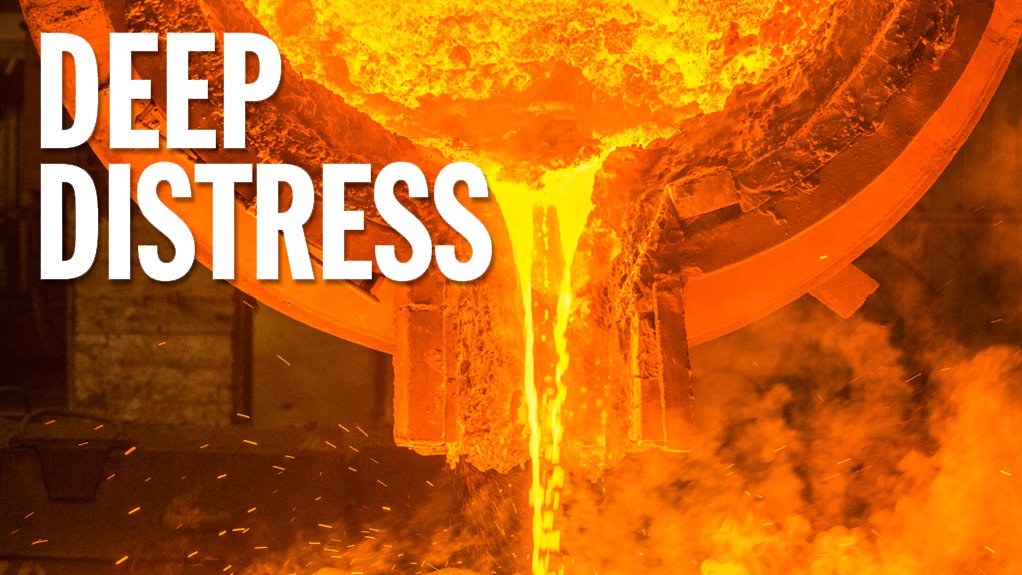Pandemic dashes hopes for a domestic steel sector turnaround





MICHAEL ADE The industry is under duress and will continue to struggle over the next two years before showing mild signs of green shoots
Photo by Creamer Media's Donna Slater
DESTINATION UNKNOWN Forecasts and the overall economic outlook is difficult to determine owing to Covid-19 having distorted local and international value chains
ERIK SARDAIN The South African steel industry may not collapse, but the risk is that its slow and steady decline will continue
The international Covid-19 outbreak, which has disrupted the South African and global economies, has thrown another “spanner in the works” for the already embattled domestic steel sector and could seriously hamper, or even prevent, a recovery.
The pandemic has already ruined any hopes for a turnaround this year, with industry expectations leaning towards the sector’s sinking further into torrid territory.
Covid-19 has distorted local and international value chains, with the overall economic outlook and other forecasts also difficult to determine. This follows on the back of the first steel recession outside of China last year, and a decline in steel exports from South Africa to key markets, such as China and India, from about ten-million tonnes in 2010 to about seven-million tonnes in 2019.
Shutdown measures implemented by the South African government in March in response to the Covid-19 pandemic have hugely impacted on local steel manufacturing activity and steel-consuming industrial sectors, while the full negative impact of the pandemic on the steel sector will largely be seen in the sales, production and capacity utilisation data of the second quarter of this year, says industry association Steel and Engineering Industries Federation of Southern Africa (Seifsa) chief economist Dr Michael Ade.
Additionally, steel production has dipped and domestic consumption is generally low, while administered prices of raw materials have steadily been increasing. Business activity has also been stagnant in recent years and has been further deteriorating in 2019 and early 2020, with companies generally struggling, owing to poor industrial fundamentals.
“It’s clear that the industry is under duress and will continue to struggle over the next two years, especially as it is coming from a weak base, before showing mild signs of green shoots,” says Ade, who believes that the industry will survive the storm.
Research consultancy Roskill steel alloys principal consultant Erik Sardain, meanwhile, highlights that the South African steel industry “suffers from structural problems” that existed before Covid-19, with “a slow and gradual degradation of the country’s economic environment” making the local steel industry increasingly uncompetitive.
After a poor 2019, marked by a weaker global economy, trade frictions and geopolitical tensions, Sardain laments that 2020 “will be even worse”, owing to the pandemic.
Roskill forecasts that global steel production, excluding Chinese production, will drop by 13% to 15% year-on-year, depending on the duration of the various levels of lockdown worldwide, and how the recovery from the crisis is managed.
“The sooner governments lift lockdowns, the sooner activity can restart,” Sardain notes.
Thus, Roskill’s base case scenario remains a deep V-shaped recession, with a global recovery in 2021, although a more prolonged recession scenario “cannot be ruled out”.
However, while the world should recover from Covid-19 in 2021, Sardain is less certain about the future of the South African steel industry.
With tariffs and import duties off the table as potential solutions because they make downstream products more expensive, he notes the need for a different direction to make the industry more competitive.
“If it does not happen, the South African steel industry may not collapse, but the risk is that its slow and steady decline will continue.”
He warns that, similar to any other crisis, Covid-19 “could act as a catalyst” for the local steel industry’s demise.
Ade also suggests that urgent timely interventions are required to revive business activity and ensure the industry’s survival. While applauding existing initiatives – such as various funding or loan relief packages from government, local banks and civil society – he recommends targeted cash flow interventions, alongside production incentives from government, and targeted financial support for local steel companies on a case-by-case basis.
Policymakers “should continue to promote the concept of buying local and encourage all State-owned businesses to adhere to using products and inputs designated for local production”, he adds.
Ade says there is also an urgent need to protect the production capacity of the local steel industry by closely monitoring imports to prevent the excessive dumping of raw materials and intermediate steel products onto the local market.
He makes this recommendation on the basis that key trading-partner countries have opened up their economies (after the initial ravages of the Covid-19 pandemic), while some have, so far, been quick to relax the levels of restricted economic activity earlier than South Africa.
“Given the Covid-19 context and existing challenges faced by companies in the local steel value chain, there is clearly a need to rejig relevant policy measures in the steel industry in line with the ‘new normal’. We cannot maintain the same mindset that we had prepandemic,” Ade avers.
Survival Measures
According to research organisation Trade and Industrial Policy Strategies’ (Tips’) April 2020 policy brief on the South African steel industry, feedback from the downstream steel fraternity is “extremely pessimistic” from the demand and cash flow perspectives. The brief also states that local steel demand comes from “a departure point of progressive weak demand, owing to a faltering economy”.
Considering that there already was insufficient demand to justify the fixed costs of the installed base of capability and jobs before Covid-19, Tips says the consequent lockdown regulations will reduce South Africa’s gross domestic product, with demand for steel to decline even further, and faster.
Cash flow, which has been fundamentally disrupted by Covid-19, will remain a concern and, with no sales during the lockdown, there are no funds to pay the bills, according to the policy brief.
Tips says the mismatch between product, service supply and demand, as well as cash flow issues, will accelerate retrenchments or the closure of companies whose balance sheets are not capable of dealing with the implications of Covid-19.
Further, halting steel production, even for only one or two months, will have a significant impact on suppliers to the industry. There is no demand for services and consumables that are part of ongoing operations – for example, the supply of refractory bricks – when steel production is halted. Many small and medium- sized companies that are part of the eco-sphere of a steel plant will struggle without ongoing production, and some will close.
Against this background, Seifsa is advocating for a reduction in imports, while boosting local manufacturing, demand, procurement and incentives.
“We hope that key drivers of international steel demand, including China, will equally come to the party and boost consumption. However, the essence is to be inward-looking in the short to medium term, and financially support local companies to boost constricting cash flow and reboot production,” Ade explains.
These interventions will reduce job losses significantly, and help the sector on its road to recovery.
Tips suggests that the Industrial Development Corporation create a temporary lending facility to provide payment-term relief for customers of the steel industry, which would enable steel mills to offer extended payment terms, rather than the standard 30 days.
“This will enable South Africa-based manufacturing to weather the short-term impact on cash flows,” the organisation says, noting that another possible mechanism to unwind credit could be a 5% repayment per month for the next 12 months, with a payment holiday in December or January. Repayments could start three months after the end of the lockdown.
The organisation also calls for more clarity on exports, which have cost implications for firms, and says that interventions also need to cater for large businesses with a turnover of more than R50-million a year, as these businesses “are not coming from a position of strength”, owing to the difficulties encountered over the past few years.
Additionally, with the steel sector’s Master Plan process under way, Tips says it “would need to be reshaped to ensure that it supports structural improvements for an industry that has been severely impacted by Covid-19”.
Global Numbers
Industry research firm Fitch Solutions expects the steel market to be in a slight surplus of 12.6-million tonnes in 2020, compared with a deficit of 11.9-million tonnes in 2019. The firm expects the surplus to narrow to 12.1-million tonnes and 4.7-million tonnes by 2021 and 2022 respectively.
In terms of production, Fitch Solutions forecasts global growth at 3.2% year-on-year in 2020, rising to 4.2% year-on-year in 2021, after averaging 4.4% year-on-year in 2019. Growth will subsequently slow over the years and average 0.7% year-on-year by 2029. Global steel production growth will average 2.1% year-on-year from 2020 to 2029, compared with 4.5% year-on-year from 2010 to 2019.
Global steel consumption growth is forecast to increase from 1.9% year-on-year in 2020 to 4.2% year-on-year in 2021, compared with 4.1% year-on-year in 2019. This will be driven mainly by China, as there will be year-on-year growth in steel consumption of 4% and 7% in 2020 and 2021 respectively in the country, on the back of strong demand from infrastructure, driven by targeted government stimulus.
Global consumption, meanwhile, is forecast to increase from 1.9-billion tonnes in 2020 to 2.3-billion tonnes by 2029.
Roskill’s base case scenario is a V-shaped recession with a 2020 world steel production of over 1.7-billion tonnes, with China producing 991-million tonnes and an apparent South African consumption of about 3.5-million tonnes.
Seifsa is yet to finalise its first-quarter review, but it expects local steel production to dip by as much as 50% and consumption by 30% from last year’s volumes, as companies across the value chain struggle with cash flow problems, poor competitiveness and loss of productive capacity and efficiency, owing to constricting demand domestically and globally from key consumers, such as China, India and the rest of Africa.
Article Enquiry
Email Article
Save Article
Feedback
To advertise email advertising@creamermedia.co.za or click here
Comments
Press Office
Announcements
What's On
Subscribe to improve your user experience...
Option 1 (equivalent of R125 a month):
Receive a weekly copy of Creamer Media's Engineering News & Mining Weekly magazine
(print copy for those in South Africa and e-magazine for those outside of South Africa)
Receive daily email newsletters
Access to full search results
Access archive of magazine back copies
Access to Projects in Progress
Access to ONE Research Report of your choice in PDF format
Option 2 (equivalent of R375 a month):
All benefits from Option 1
PLUS
Access to Creamer Media's Research Channel Africa for ALL Research Reports, in PDF format, on various industrial and mining sectors
including Electricity; Water; Energy Transition; Hydrogen; Roads, Rail and Ports; Coal; Gold; Platinum; Battery Metals; etc.
Already a subscriber?
Forgotten your password?
Receive weekly copy of Creamer Media's Engineering News & Mining Weekly magazine (print copy for those in South Africa and e-magazine for those outside of South Africa)
➕
Recieve daily email newsletters
➕
Access to full search results
➕
Access archive of magazine back copies
➕
Access to Projects in Progress
➕
Access to ONE Research Report of your choice in PDF format
RESEARCH CHANNEL AFRICA
R4500 (equivalent of R375 a month)
SUBSCRIBEAll benefits from Option 1
➕
Access to Creamer Media's Research Channel Africa for ALL Research Reports on various industrial and mining sectors, in PDF format, including on:
Electricity
➕
Water
➕
Energy Transition
➕
Hydrogen
➕
Roads, Rail and Ports
➕
Coal
➕
Gold
➕
Platinum
➕
Battery Metals
➕
etc.
Receive all benefits from Option 1 or Option 2 delivered to numerous people at your company
➕
Multiple User names and Passwords for simultaneous log-ins
➕
Intranet integration access to all in your organisation






















